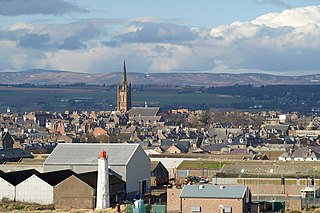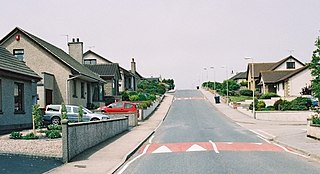
Aberdeen is a city in North East Scotland, and is the third most populous Scottish city. Historically, Aberdeen was within the historic county of Aberdeenshire, but is now separate from the council area of Aberdeenshire.

Montrose is a town and former royal burgh in Angus, Scotland. Situated 28 miles north of Dundee and 37 miles south of Aberdeen, Montrose lies between the mouths of the North and South Esk rivers. It is the northernmost coastal town in Angus and developed as a natural harbour that traded in skins, hides, and cured salmon in medieval times.

The A90 road is a major north-to-south road in eastern Scotland, running from Edinburgh to Fraserburgh, through Dundee and Aberdeen. Along with the A9 and the A82 it is one of the three major north–south trunk roads connecting the Central Belt to northern destinations. The A90 is not continuous, separated between Dalmeny and Perth by the M90.

The A92 is a major road that runs through Fife, Dundee, Angus, Aberdeenshire, and Aberdeen City in Scotland. From south to north, it runs from Dunfermline to Blackdog, just north of Aberdeen.

Ellon is a town in Aberdeenshire, Scotland, approximately 16 miles north of Aberdeen, lying on the River Ythan, which has one of the few undeveloped river estuaries on the eastern coast of Scotland. It is in the ancient region of Formartine. Its name is believed to derive from the Gaelic term Eilean, an island, on account of the presence of an island in the River Ythan, which offered a convenient fording point. In 1707 it was made a burgh of barony for the Earl of Buchan. It is home to a unique collection of ancient yew trees.

The Forvie National Nature Reserve is a national nature reserve owned and managed by NatureScot. It is located north of Newburgh in Aberdeenshire, in the northeast of Scotland. The reserve includes the Sands of Forvie, which are the fifth largest sand dune system in Britain, and the least disturbed by human activity. The dune system is an integral part of the Ythan Estuary, which also forms part of the reserve, and separates the sands from Balmedie beach.

Cruden Bay is a small village in Scotland, on the north coast of the Bay of Cruden in Aberdeenshire, 26 miles (42 km) north of Aberdeen.

Kintore is a town and former royal burgh near Inverurie in Aberdeenshire, Scotland, now bypassed by the A96 road between Aberdeen and Inverness. It is situated on the banks of the River Don.

The Gordon Highlanders was a line infantry regiment of the British Army that existed for 113 years, from 1881 until 1994, when it was amalgamated with The Queen's Own Highlanders to form The Highlanders. Although the 'Gordon Highlanders' had existed as the 92nd Regiment of Foot since 1794, the actual 'Gordon Highlanders Regiment' was formed in 1881 by amalgamation of the 75th (Stirlingshire) Regiment of Foot and 92nd Regiment of Foot.

St Fergus is a village in the Buchan area of Aberdeenshire, Scotland. St Fergus lies 1 mile (1.6 km) from the North Sea coast and 3 miles (5 km) north-west of Peterhead. The Parish of St Fergus includes the remains of Inverugie Castle and Ravenscraig Castle. The church in the village was built in 1763. The church for this parish previously stood in the old kirkyard near the shore 2 miles (3 km) to the east. This site on the St Fergus Links is still used as a burial ground. Prior to the change in site of the church the parish was known as Longley and at a still more remote period Inverugie.

Balmedie is a large village in Aberdeenshire in Scotland. It lies north of the city of Aberdeen, in the civil parish of Belhelvie. The long and wide beach is bordered by an extensive dune system that stretches 14 miles (23 km) from Aberdeen to just north of the Ythan Estuary at Newburgh. The dynamic dunes have marram grass as the principal vegetation. They support a large array of wildlife. Two watercourses make their way to the sea within the area creating ribbons of wetland vegetation along their course. The village is near the Sands of Forvie Site of Special Scientific Interest, the fifth largest sand dune system in Britain; this is an integral part of the Ythan Estuary, which separates the sands from Balmedie Beach.

Embo is a village in the Highland Council Area in Scotland and the former postal county of Sutherland, about two miles north-northeast of Dornoch.

The Aberdeen Western Peripheral Route (AWPR), unofficially also the City of Aberdeen Bypass, is a major road that wraps around the city of Aberdeen, Scotland. The road stretches north from Stonehaven through Kincardineshire and crosses both the River Dee and River Don before terminating at Blackdog. The main stretch of the AWPR is 22 miles (35 km) in length.

Air Marshal George Mitchell Croil CBE, AFC was an American-born Canadian Royal Flying Corps pilot during World War I who went on to become the first Chief of the Air Staff of the Royal Canadian Air Force. Croil resigned as CAS in 1940 and then served as Inspector-General of the RCAF until his retirement in 1944, when the post of Inspector General was abolished.

Boddam is a coastal village in Aberdeenshire, Scotland. It is 29 miles (47 km) north of Aberdeen and 3 miles (4.8 km) south of Peterhead. The settlement of Stirling Village lies immediately to the west. Sea cliffs rise to 200 feet (61 m), south of the village: a coastal path leads along these to the Bullers of Buchan.
2BD was a local radio station opened on 10 October 1923 in Aberdeen, Scotland, by the British Broadcasting Company. Operating from a studio at the rear of a shop belonging to Aberdeen Electrical Engineering at 17 Belmont Street and a transmitter located on the premises of the Aberdeen Steam Laundry Company, the station broadcast on a frequency of 606 kHz medium wave.

153rd Infantry Brigade was a formation of Britain's Territorial Force/Territorial Army that was part of 51st (Highland) Division in both World Wars. From its origins in the 19th Century Volunteer Force it was based in Aberdeen and was composed of Highland battalions. It served on the Western Front in World War I, and after it was captured at Saint-Valery-en-Caux early in World War II it was reformed from its 2nd Line and saw action in North Africa, Sicily and North West Europe. It continued serving postwar until the reduction of the Territorial Army in the 1960s.
Alistair Urquhart was a Scottish businessman and the author of The Forgotten Highlander, an account of the six and a half years he spent as a Japanese prisoner of war during his service in the Gordon Highlanders infantry regiment during the Second World War.
The 216th Brigade was a Home Service formation of the British Army during the First and the Second World Wars.
The European Offshore Wind Deployment Centre (EOWDC), also known as the Aberdeen Bay Wind Farm is an offshore wind test and demonstration facility located around 3 kilometres off the east coast of Aberdeenshire, in the North Sea, Scotland. It was developed by the European Offshore Wind Deployment Centre consortium. The scheme is relatively small - it consists of 11 wind turbines with an installed capacity of 93.2 megawatts. It is located between Blackdog and Bridge of Don near Aberdeen. First power was generated in July 2018, with full commissioning following in September 2018.



















